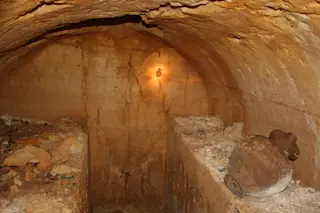A look inside the Etruscan tomb at the two platforms and the remaining vases. As archaeologists in Italy chipped through a stone seal and rolled away a stone last week, light shone into an ancient Etruscan tomb for the first time in 26 centuries, illuminating a mysterious civilization of old. Etruscan society ruled the peninsula we now call Italy for hundreds of years before being taken over by the Romans. Discovery News reported:
Since their puzzling, non-Indo-European language was virtually extinguished (they left no literature to document their society), the Etruscans have long been considered one of antiquity's great enigmas... Only the richly decorated tombs they left behind have provided clues to fully reconstruct their history.
Pots found in the tomb of the Etruscan warrior prince. This tomb was no exception. In fact, this find was especially rare since it housed royalty. Jars and vases found outside the tomb evidenced ...














